
The Africa that piqued my childhood interests no longer exists. The continent’s colorful history, the topography and climate, teeming wildlife and early farmer settlers seem to have been crushed under the weight of revisionists politics, racism, religious wars, and intrusive tourism. Many of the classic stories have been reinterpreted in university study guides and analysis to suit a modern theme; the surrender of ideas to ideologues.
My early impressions of Africa can still be found in the writings of Joseph Conrad, Peter Capstick, J. H. Patterson, Theodore Roosevelt, Robert Ruark, or John Taylor. Colorful, beautiful, dangerous…. mysterious Africa. A wonderful work of nature where hunts last half a year and charging elephant, rhino, cape buffalo, and lions are shot at 15 yards… each expiring at the feet of a steadfast hunter.
I like live elephants, but I still like big guns…
I like to hunt and I am fairly good a it; spend enough time at anything and some modicum of skill will eventually develop. Trophy hunting has never been of much interest to me, probably because it is hard to stock a freezer with antlers and hides and it seems like such a waste of an animal. No, I don’t take exception to others wanting to hunt for the big and the bad as long as sportsmanship and fair chase are included in the hunt.
For me, majestic animals are always so much more… majestic when still breathing and a shot elephant hardly represents a trophy. Trumpeting with big ears splayed, its unsteady lumbering movements, deflated wrinkled hide draped loosely over gigantic bones, a collapsing elephant looks more like an old man who has lost his balance and is helplessly falling. The hunter appears a dandy, armed mostly with too much money and too little character and sanctimonious in describing his or her accomplishment.
Still, I love big bore rifles. The roar, the recoil, the challenge to shoot them accurately completes my imaginary Africa. I never cease to marvel at the power and accuracy of these big guns, even if just for shooting at a range. Unlike the side by side 577 NE and 600 NE, the Ruger Hawkeye African in 416 Ruger doesn’t require hiring a detective to locate $50/round ammo or spending $50,000 on a firearm.
Sporter weight… You’ll get a kick out of this
The Ruger African by size and shape, ignoring that big hole at the end of the barrel, would not stand out in a rack filled with deer rifles. The Ruger is a relatively light sporter without excessive girth or guppy belly profile stock to suggest the 416 Ruger is every bit as powerful as the jumbo size 416 Rigby; 400 grains @ 2,400 fps and 5,116 ft/lbs of energy at the muzzle.
|
Ruger Hawkeye African |
|
| Point of Origin | Newport, New Hampshire |
| Model# | 37185 |
| Action Type | Bolt Action – two lug |
| Caliber | 416 Ruger |
| Mag Capacity | 3+1 |
| Barrel Length | 23″ |
| Rifling | 1:14″ |
| Weight | 7.88 Lbs |
| Overall Length | 44.88″ |
| Stock | American Walnut / Ebony Tip |
| Drop at Comb / Heel | 0.50″ / 0.75″ |
| Length of Pull | 13.50“ |
| Sights | Adjustable Rear – Ramped Front |
| Hardware Top / Bottom | Blued Carbon Steel |
| Bottom Metal | Blued Carbon Steel |
| Trigger Type / Pull | LC6 / 4 Lbs 3 Oz. |
| Safety | 3 Position wing Safety |
| MSRP | $1199 |
| Nominal weights and Dimensions | |
A quick calculation puts recoil at approximately 81 ft/lbs. Subsequently, the attractive, slender red recoil pad would suggest that the folks at Ruger have a sense of humor. However, they are not a company without compassion, so they’ve packaged the Ruger Hawkeye African with the company’s very effective detachable muzzle brake system. The Ruger radial port brake reduces recoil to the tune of 40% to 50% by slowing and redirecting gases away from the rifle’s muzzle that would normally generate high levels of secondary recoil.
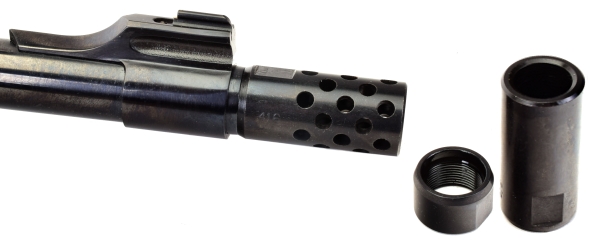
Brake, muzzle weight and thread protector are included with each firearm. If the rifle is sighted in with the brake in place and then removed, the muzzle weight (far right) should be installed to replace the mass of the brake and to maintain point of impact. However, the rifle can also be zeroed and taken hunting with only the thread protector, center, in place.
Ruger labels the African’s rear sight as windage adjustable express type, the rifle’s ramped front sight sports a large white bead. The set up is elevation calibrated to 50 yards. Often implemented as three fixed blades mounted on a quarter rib with elevation preset for 100, 200 and 300 yards, an express sight is any shallow V rear sight using fast “apple on the stick” sight alignment.
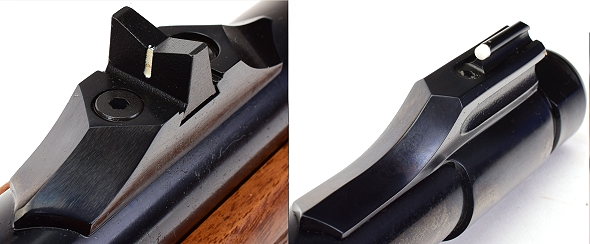
It might seem, at first look, that the inability to adjust elevation is a limitation; theoretically yes. However, as a practical matter… not so much. “Explain yourself, Joe!”. I will. A 400 grain 416 Ruger load, leaving the rifle’s muzzle at a leisurely 2,400 fps, has a point blank range of 240 yards on a +3″ ordinate and drops only 10″ at 300 yards. Not a lot of hold over head scratching required for most hunting circumstances that would apply to this type of combination. “But I want to shoot prairie dogs at 500 yards during the off season”. Of course you do – mount a scope; rings are included.
The Ruger scope mount system is a good one. Clamping on the sides, keyed at the top, they stay put, yet they are quick to come off and go on without losing zero when desired. Normally, quick detachable mounts are kind of a yawn as they are rarely used. They do make sense on a rifle of this type where applications may require removal and reinstallation during a single outing.
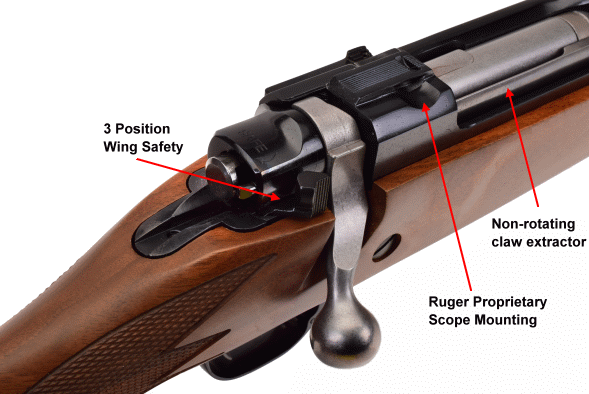
Two other features useful in a rifle of this type; controlled round feed with beefy extraction and a three position safety that locks the cocking piece when the rifle is in full safe. The magazine can be emptied by releasing the rifle’s floorplate or by placing the safety in its middle position, which allows the bolt to be cycled with the trigger sear blocked. This feature also allows topping off the magazine.
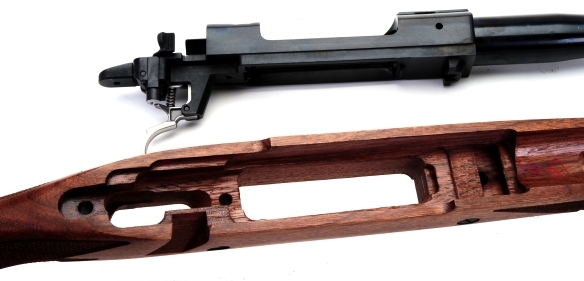
The Ruger Hawkeye African is closely inletted, supported solidly at the receiver’s tang and recoil lug with the barrel floating. Cross bolts through the stock take up some of the stress under recoil load.
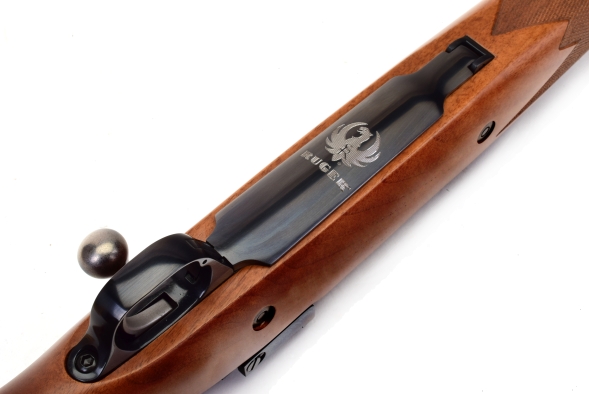
Bottom side metal is all steel; something not seen much these days with aluminum bottom metal more typical. In the case of the Ruger with its square bottom receiver, it makes for a very strong and stable stock sandwich and contributed a good deal to the Ruger’s consistent accuracy.
OK, so a 416 is actually a medium bore…
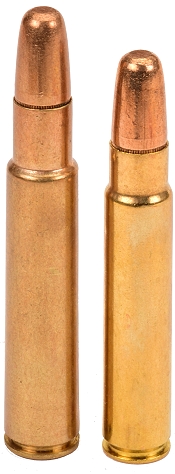
In the world of cartridges designed to put down big and dangerous animals, the 45 caliber and up are considered big bore with .577 & 600 Nitro Express doubles leading the parade. Still, the 416 rounds are legal for hunting the largest game where the 375 H&H is considered to be not quite enough. Pictured 416 Rigby far left, 416 Ruger left. For the sake of context, and for filling in some of this blank white space –
|
Cartridge |
Bullet Grains |
Case Diameter |
Case Length |
COL | Capacity Grains |
Max KPSI |
MV* FPS |
ME* Ft/Lbs |
| 416 Weatherby | 400 | 0.582 | 2.913 | 3.750 | 140 | 63.8 | 2700 | 6474 |
| 416 Rigby | 400 | 0.589 | 2.900 | 3.750 | 127 | 47.2 | 2415 | 5180 |
| 416 Remington | 400 | 0.513 | 2.850 | 3.600 | 107 | 62.3 | 2400 | 5116 |
| 416 Ruger | 400 | 0.532 | 2.580 | 3.340 | 104 | 62.0 | 2400 | 5116 |
| 375 H&H | 300 | 0.513 | 2.850 | 3.600 | 95 | 62.4 | 2530 | 4263 |
|
*Hornady’s Dangerous Game Ammunition |
||||||||
The Weatherby and Rigby are very similar cartridges with the exception of the Weatherby’s belt. The Weatherby’s increased capacity comes from less taper and a slightly shorter neck. A further boost to the Weatherby’s performance comes from it higher maximum pressure.
The 416 Remington is a full length belted magnum, meaning it is based on the original 375 H&H with its neck opened to accept a 0.416″ bullet and the case body has been straightened to remove most of the 375 H&H’s taper to increase capacity. Both of these cartridges require a full length or magnum length action.
The 416 Ruger represents a different approach to achieving 416 Rigby and/or 416 Remington levels of performance. The case body diameter is about the same as the belt diameter of an H&H case. Subsequently, even shortened to work through standard 30-06 Springfield action, it has near the same capacity as the full length 416 Remington. From first hand experience, being able to build a custom rifle from a seasoned 30-06 rifle makes such projects quite cost effective.
Factory ammo versus handloads
Only one company produced brass and ammo for the 416 Ruger, the cartridge’s co-developer Hornady. This has not been a problem as both have been in stock and available from discount retailer on the Internet and through larger chain stores. Loaded ammo is available in two forms; 400 grain solid round nose and 400 grain expanding round nose which, for the most part, should cover just about every 416 Ruger opportunity. The rub is that other 0.416″ bullets can be very slick in BC and they are available in weights from 300 to 450 grains which means the 416 Ruger has a great deal of potential beyond the two factory loads.
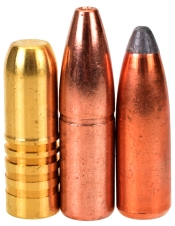 The Hornady DGS factory ammo, Dangerous Game Solid is loaded with a lead core, steel jacket, copper clad bullet with a .319 BC. The Hornady DGX factory ammo is loaded with a similar bullet, however, it is open at the tip and the 0.093″ thick jacket is serrated at the nose to promote penetration and controlled expansion with the same B.C..
The Hornady DGS factory ammo, Dangerous Game Solid is loaded with a lead core, steel jacket, copper clad bullet with a .319 BC. The Hornady DGX factory ammo is loaded with a similar bullet, however, it is open at the tip and the 0.093″ thick jacket is serrated at the nose to promote penetration and controlled expansion with the same B.C..
From left to right: The Barnes Banded Solids have a large meplat to keep them tracking straight in dense muscle and bone, which leaves them with a .216 BC. The bands relieve pressure and cut bore friction as an accommodation to the copper/zinc allow solid construction. Banded solids are 0.001″ smaller in diameter than other types of Barnes bullets. They are machined from bar stock, very tough and they do not deform on impact.
Part of my stash of Barnes X bullets from pre-civil war days have a BC of .392 and have proven to be very accurate. Their primary problem is a solid shank that can lead to copper fouling if left unattended and the increased bore friction of a solid shank requires care in working up handloads to avoid excessive pressure.
The Hawk Spitzer is 400 grains and has a 0.050″ dead soft copper jacket which allows expansion by 2x to 3x diameters while still retaining 95% of their original weight. They are listed as having a BC of .500. Versions are available with both thinner and thicker jacket material and with and without a cannelure. They hold up well on game and they are easy on rifle barrels.

Email Notification